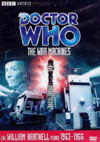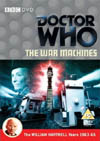The War Machines
 |
 |
 |
DVD NTSC
Region 1




|
DVD PAL
Region 2


|
VHS Video
NTSC
 A A

NTSC
 B B

NTSC


PAL


|
|
(Doctor Who Story No. 27, starring William Hartnell)
- written by Ian Stuart Black, based on an Idea by Kit Pedler
- directed by Michael Ferguson
- produced by Innes Lloyd
- featuring library music
- 4 episodes @ 25 minutes each
|
Story: The Doctor and Dodo land in London near the
monumental Post Office tower just after its completion
in the 1960's. But the Doctor has ominous feelings about
the new WOTAN computer that Earth authorities are about
to hand control over to - a computer that soon exercises
hypnotic control over any human mind that comes too close.
Is it already too late for Dodo? What dangerous machines is WOTAN
having built in a disused factory? Ben Jackson and Polly
make their Doctor Who debuts.
|
|
DVD Extras include:
- Audio commentary with actress Anneke Wills (Polly),
and director Michael Ferguson.
- "Now and Then" Location Featurette
- Compilation of related "Blue Peter" segments.
- Featurette on the Post Office Tower with Tony Benn.
- WOTAN Assembly - restoration featurette.
- War Machine design plan
- Pop-up Production Note Subtitles
- Photo gallery
Buyers' Guide Review
by Martin Izsak
|
|
(A more in-depth analysis, containing "SPOILERS" and intended
for those who have already seen the program, can be accessed
here.)
|
Season three turns out another winner, the best of its surviving
complete stories. The format of a monster menace confronted
by a heroic military in contemporary times is defined here for the
first time in Doctor Who, a format that will ultimately culminate in
the creation and perpetuation of UNIT and its commanding Brigadier.
It's very good to see that this type of story is handled just as
excellently by William Hartnell's Doctor as with many of the others -
too bad Hartnell didn't get more stories of this type.
|
The background information about the "new" Post Office Tower
in London from a contemporary "Blue Peter" broadcast,
detrimentally placed first on the VHS video version, does enhance the
Doctor Who story, however "Blue Peter's" introduction of the war
machines does more to take away from their sense of menace and
mystery. Thus throughout the first two episodes, I dreaded that
the machines would be a near total cinematic flop. However,
Michael Ferguson does some creative cinematic work in bringing
the menace in them to life. The machines work well within the
story, and would probably work better on the video for first
time viewers if their investigation by Blue Peter was NOT placed first.
Instead of building the machines
up, Blue Peter actually pulls them down.
|

|
Also weighing against the Blue Peter snippet are all the plot
spoilers needlessly thrown away. Would you rather experience
a fresh Who story by watching it, or by listening to it being blabbed
from the mouth of a Blue Peter presenter? The presenter should ask
the questions that will occupy the Doctor's mind, not give away all
the answers. His final comment that he is most interested in
tuning in to the adventure on Saturday is at last back on track
of getting us interested. It is question-oriented.
Let's hope the Blue Peter bit learns its rightful place amongst the rest
of the bonus featurettes on the DVD, and does not try to automatically
precede the actual episodes.
The TARDIS is done quite well coming and going, and the
dematerialization sound is even reversed for the landing once more,
although this is to feature the slowing whine descending over London.
The wheeze and groan of the Police Box as it appears is still the
wrong way around.
The Doctor is present and heavily involved throughout all four
episodes. The sudden easy cooperation of all of the guest characters
is unnatural however, especially as they are all strangers. This
is because scene two is missing, in which the Doctor presents himself
to Green, having forged some papers and dropped the familiar name of
science master Sir Ian Chesterton. One has to turn to the novelization
for that lovely bit, whereas on TV, one assumes that it simply happened
without having the cameras on hand to record it. As story structure
goes, episode one is a little too tight, while episodes two and three
have more breathing room than they actually require. Finding a way
to re-include the missing scene would have made the story that much
better.
The contemporary setting works wonders in making the story much
more believable than many other science fiction offerings, and provides
strong viewer-familiarity with character motivations, official
procedures, sets and props, etc. The story can take good advantage
of not having to explain all this, and gives us a tighter plot with
a faster pace.
Michael Ferguson's defining drawback seems to be in the editing
of sequences of shots, which again relies on the compositions of the
shots themselves. Ferguson's sequences always seem to be more
transitional than suspenseful, when his work is compared with that
of other directors. It's a far cry above Blue Peter, and Richard
Martin isn't even in the same league to be able to do transitional,
so this is a minor consideration that only seems to be noticeable
with repeat viewing - on the whole everything works in "The War
Machines", especially on first viewing.
Dodo's role in this story is more interesting than much of what
she did during "the dregs" of season three (stories 22-25:
"The Massacre",
"The Ark",
"The Celestial Toymaker",
"The Gunfighters"),
even though she misses out on getting as much screen time as before.
"The War Machines" still offers a better
look into her character than most other stories have managed so far.
Polly's entrance is a tad strange, as we are mostly looking at
the back of her head, interrupted by a brief close-up of a sarcastic
face-wrenching expression from her,
but Anneke Wills soon gives a worthy performance to a wide-ranging
role. Ben Jackson is a likeable character, and proves to be an
excellent sidekick for the Doctor from episode two onwards. His
"rescue" of Polly in the first episode shows character traits that make
a refreshing change from Sir Ian.
His accent
is also entertaining. Michael Craze puts a lot into the performance,
and it is very enjoyable. Ben's background as a sailor seems to serve
this story and the next one exceptionally well, but afterwards it seems
to leave Ben a bit at sea in general science fiction settings.
|
Episode three contains a frustrating scene. As the Doctor, Ben,
and Sir Charles attempt to come up with a plan of action, the Doctor
continually leads the others down many various aisles of thought,
then obstructively shoots down the natural conclusion of each one.
What exactly he has in mind is very unclear, and the first Doctor's
skills in working in a group leave much to be desired at this time.
Why can't the Doctor just come to the point? At least direction
is arrived at eventually.
|
|
Library music tracks:
"Asyndeton" is available on:
|
|
Computer knowledge is accurate enough for its day, even managing
a foreshadowing of a type of internet, but it all becomes farfetched
in terms of a global desire to give up responsibility for making
choices to a machine, or in terms of the programmers' lack of
responsibility and ability to control the decision-making process.
If IBM or Microsoft were to take control of computers everywhere
today, you could be certain there would be people behind it all pulling
the strings. The strangest bit in all of this is that Sir Charles
feels he needs to explain what programming is to a fellow official.
Were they really about to hand over their power in such ignorance?
Kit Pedler must have been more of a cyberman than we know to base
his ideas on these premises.
Ian Stuart Black, on the other hand, balances this with more
esoteric considerations. As in
"The Savages" (story no. 26),
a sixth sense is at
work in the Doctor, drawing him to investigate the tower with more
than just simple curiosity. Brett also senses Wotan's presence
in the computer room. Is there holographic memory at work, allowing
some power-hungry soul to inhabit Wotan and power its intelligence?
Are the powerful electro-magnetic fields present as a mere product of
electronic circuits, or are they by-product expressions of a more
insidious consciousness that has unwittingly been given solid
manifestation through electronics? (Say hello to the Yeti in
later years.) If Wotan has something comparable to a soul, as Ian
Stuart Black begins to hint at, and its electronic brain channels
this `soul' in a similar way to our own organic brains, the
power-hungry computer idea now becomes much more believable.....
The two philosophies merge further in terms of the Doctor's
solutions in the final episode, but I will save that juicy
discussion for the In-depth Analysis version
of this review so as not to reveal any spoilers.
Kit Pedler's scientific angle lends much credibility to the story,
but I enjoy all this because I bring much
of this knowledge with me into the viewing experience - unfortunately
the script cannot capitalize on it and bring this to all viewers
regardless of their background, and explaining what programming is
just doesn't hold the same fascination.
Episode Four can at least boast the spectacle of many of these
minimally explained ideas....
and a whole lot more, as it is packed tight with action and an
exciting resolution.
This story is somewhat lacking in both moral themes
and recurring guest characters, but it very healthily satisfies in
other ways. Previously adept at teaching some history and fantasizing
about science, Doctor Who is now at last capable of demonstrating and
exploring science in ways even it does not fully realize.
This story has become available on DVD and VHS video.
Click on the Amazon symbol for the location nearest you
for pricing and availability:
 |
 |
 |
DVD NTSC Region 1
for the North American market:

 in the U.S.
in the U.S.

 in Canada
in Canada
|
DVD PAL Region 2

 for the U.K.
for the U.K.
|
VHS Video
NTSC
 A A
 in the U.S.
in the U.S.
NTSC
 B B
 in the U.S.
in the U.S.
NTSC

 in Canada
in Canada
PAL

 for the U.K.
for the U.K.
|
Comments on this article are welcome. You may contact
the author from this page:
Contact page

LYRATEK.COM
|
Read the Buyers' Guide Review for the next story:
"The Smugglers"

|
|









